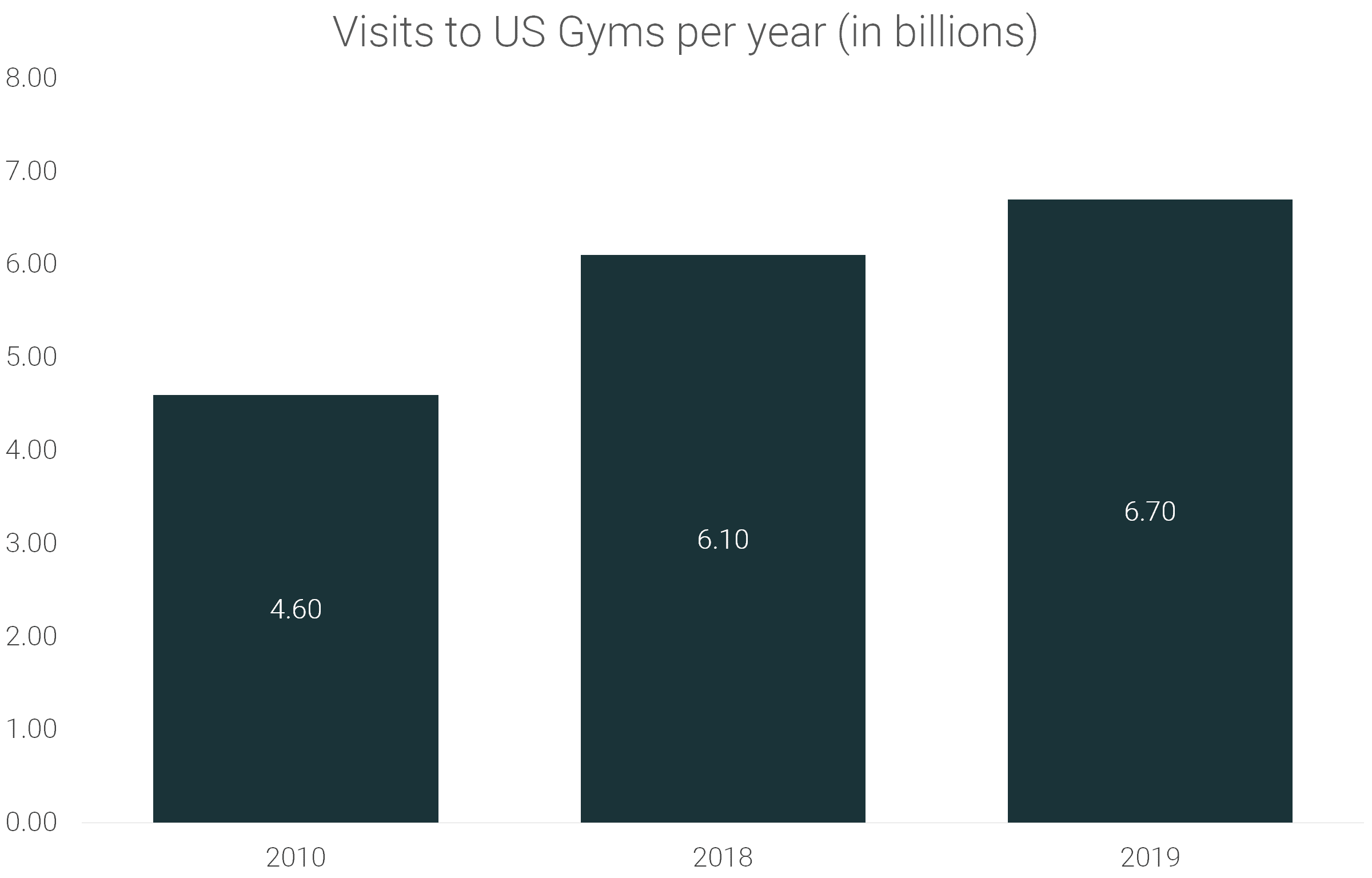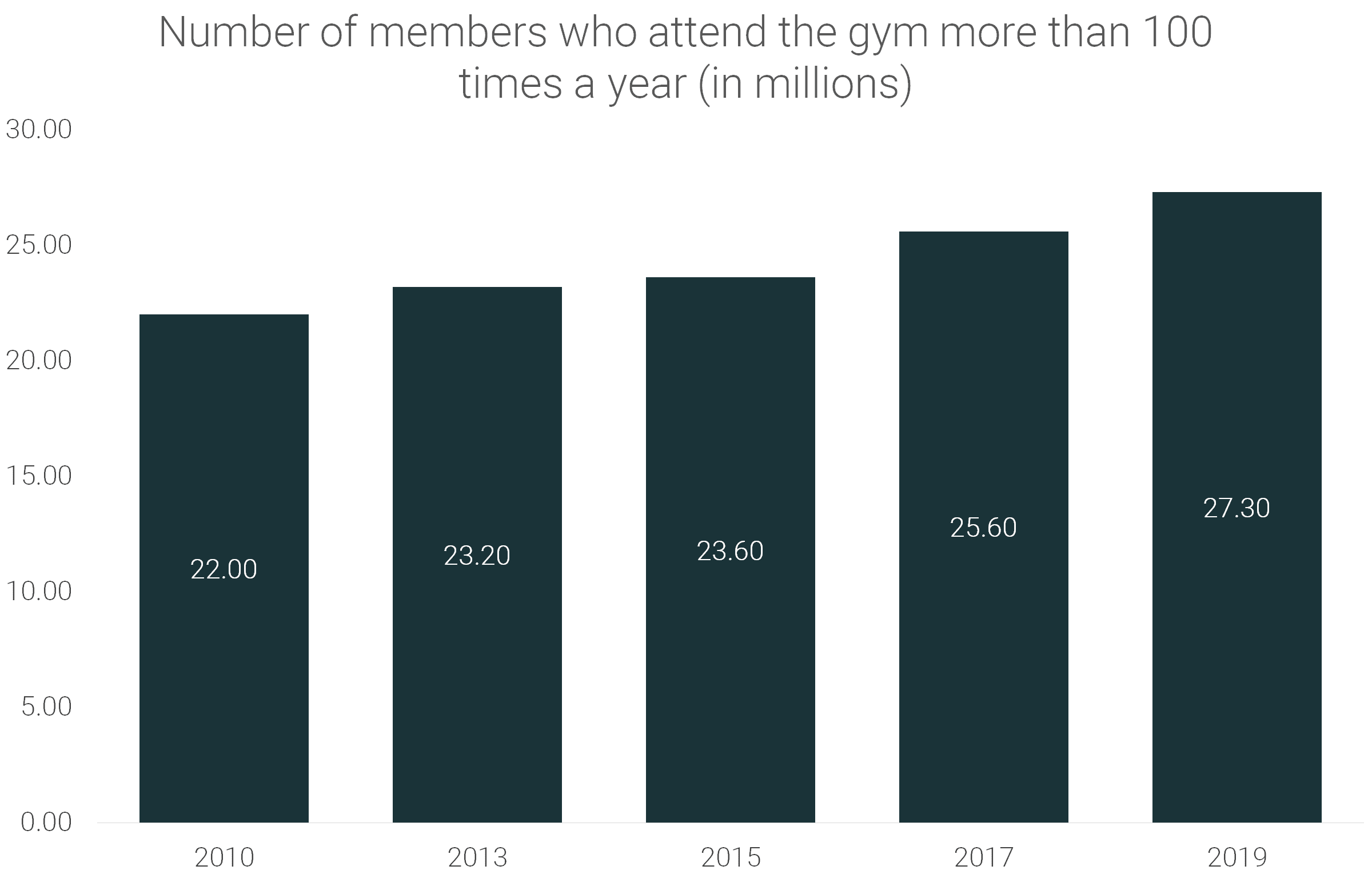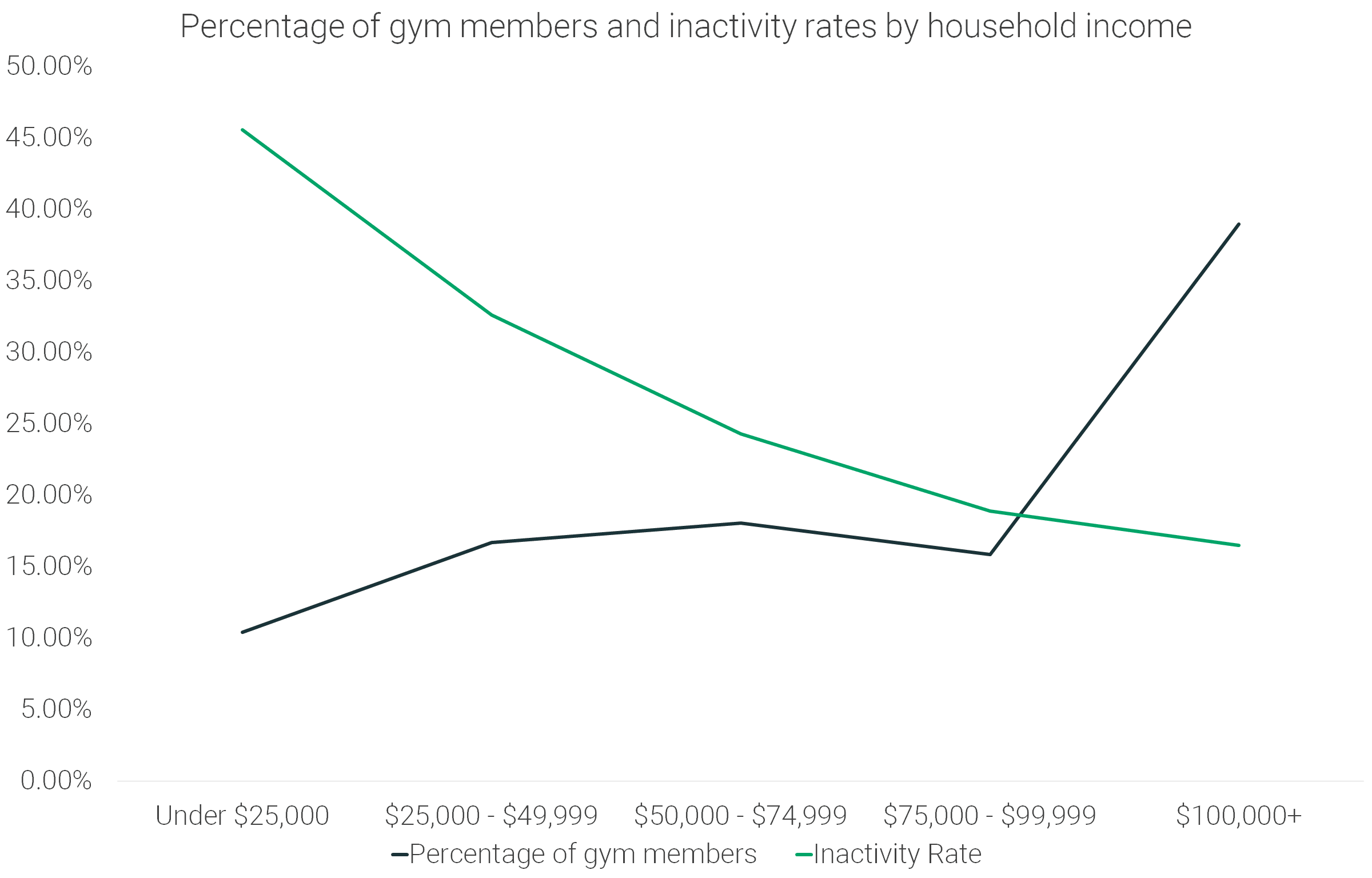77 Gym Membership Statistics, Facts, and Trends [2020/2021]

Gyms are one of the largest segments of the fitness industry, even when accounting for the more than 50% decline during the pandemic. To better understand the industry, members, and gyms themselves, we researched, read, analysed, and compiled data and facts on everything regarding gym memberships and gym members, to bring you a comprehensive breakdown of gym membership statistics.
- Gym membership statistics
- Gym attendance statistics
- Gyms least and most busy times statistics
- Gym participation statistics
- Gym equipment and exercise popularity statistics
- Gym member retention statistics
- Gym membership cancellation statistics
- Gym member new year resolutions statistics
- Gym membership demographic statistics
- Gym member age statistics
- Gym member race and ethnicity statistics
- Gym member income statistics
- Gym member education statistics
- Gym gender statistics
For additional gym statistics check out our other research, from the scientific health benefits of exercise to 200+ gym industry statistics and the 35+ stats on how COVID has impacted the fitness industry.
Top gym membership statistics for 2021
- Americans are set to spend as much as $33.25 billion on gyms, health clubs, fitness centres, and studios in 2021 [Statistia - 2021]
- Fitness industry revenue in 2020 declined by 58% compared to the previous year. [HR isa]
- By the 4th quarter of 2020, visits to gyms shrunk to 38%. [HR isa]
- After gyms were allowed to reopen, only 26% returned to the same facility, while 34% went to a different one. [Club-Intel - Dec 2020]
- 44% of gym-goers now use video-on-demand (VOD) at least once a week. [Club-Intel - Dec 2020]
- Women are 2x more likely to use VOD than men, as men are more likely to return to gyms. [Club-Intel - Dec 2020]
- The average monthly cost of a gym membership as of 2021 is $37.71. [RunRepeat - 2021]
- 70% of gym members who have returned to their facility believe the management has properly addressed COVID-19 safety concerns. [Club-Intel - Dec 2020]
- About 20% of gym members stopped going to health clubs and no longer exercise. [Club-Intel - Dec 2020]
- 57% of people who have returned to gyms choose to exercise by themselves. [Club-Intel - Dec 2020]
RunRepeat's gym membership statistics by month
Since the start of the pandemic, we have surveyed 40,435 gym members in the process of publishing 8 studies.
During the initial lockdowns (April, 2020), we surveyed 10,824 gym members and found:
- 46.67% had no plans of returning to their gyms when reopened
- A third of all gym members had cancelled (12.39%) or were considering cancelling (24.18%) their memberships
Four months later (August, 2020), we ran follow-up surveys to measure return and retention rates of members, as well as gym closures:
- Only 30.98% of members had returned to their gyms at this point in the pandemic
- 59.06% had cancelled (19.59%) or were considering cancelling (40.11%) their memberships
- A fifth of gym members reported that their gyms were still closed
In our Top Fitness Trends report (December, 2020), we asked how gym members were staying fit in 2021 and how that was changing from 2020. We found that:
- Only 15.2% of gym members saw gyms as the best way to stay fit in 2021 - dropping 63.3% from the #1 spot in 2020 (41.4%) to #3
- Nearly 3 out 4 gym members favour outdoor activities or home fitness options over gyms in 2021
When looking deeper into these avid gym members who saw gyms as their best way to stay fit in 2020, we found:
- 72.14% of those that saw gyms as their best mode to stay fit in 2020, switched to a different form of exercise in 2021.
- 39.14% of these avid gym members replaced gyms with home fitness solutions
In our most recent follow-up study of 11,193 members (March, 2021) regarding the return to gyms post-covid vaccine, we found:
- 70.97% of gym members still aren't working out at their gyms
- 34.94% of US gym members don't intend on returning, even after being vaccinated
- 29.80% of members have cancelled since the pandemic with another 25.76% having their accounts on pause
- 24.24% won't return until they themselves, their friends, and loved ones are all fully vaccinated
Gym membership statistics [pre-pandemic]
- Americans spend more than $35 billion per year on gym memberships with more than a fifth belonging to at least one gym. [HR isa]
- Gyms make an average of $517 dollars per year per gym membership. [Wellness Creative - 2020]

- Health club memberships have grown by 28% over the past decade and by 5.5% since 2018 [HR isa]
- Nearly a quarter of Americans went to a gym in 2019 (24.3%) [HR isa]
- 45.70% of gym members pay less than $30 dollars per month [Finder - 2018]
- 10.5% of gym members live with someone they met at the gym. [Nuffield Health - 2019]
- People who go to the gym are more likely to indulge in chocolate bars than people who don’t [Market Research World]
- 52.3% of gym members also have their own gym equipment at home. [Finder - 2018]
- Among UK millennials, only 19% of gym-goers prefer an annual membership, while 17% only avail of a pay-as-you-go scheme. [Go Cardless]

- 6.30% of Americans do not use their gym membership at all while 49.90% go at least twice a week.[Finder]
Gym attendance statistics
- There’s been a 9.4% increase in Americans’ frequency in visiting health clubs, gyms, or studios from 2018 to 2019. [HR isa]

- The total number of visits to US gyms reached 6.7 billion in 2019, up 45% from the 4.6 billion visits in 2010 [HR isa]
- While members anticipate visiting a gym 9.5 times per month, they only end up going 4.17 times per month. [Berkeley - 2006]

- In 2019, there were 27.3 million “Core Members”, or members who go more than 100 times a year [HR isa]
- The number of “Core Members” going 100 times or more a year increased 24% since 2010 [HR isa]
- Members went to the gym an average of 104 days a year, while 9 million non-members averaged going to the gym 24 days a year. [HR isa]
Gyms least and most busiest times statistics
- Gyms and fitness clubs are most busy at 5:30 PM on weekdays but on the weekend, they are busiest around 10:00 AM. [HR isa]
- The peak times at the gym typically associate with how the typical work day is broken up, getting busier before work, during lunch, and after work. [HR isa]
- The gym is most likely packed on Tuesdays as it is the most popular day to work out in the week. [Classpass - 2019]
- The quietest and least busy times at the gyms are early mornings (4 AM - 5 AM), late morning (9 am - 11 AM), the afternoon (3 pm - 4 pm) and at night (8 PM - 9 PM). [HR classpass isa]
Gym participation statistics
- 32.08% of people go to the gym to lose weight in the UK [Better.org.uk - 2018]
- 39.46% of UK gym members indicated that lack of time is their biggest hurdle in getting to the gym [Better.org.uk - 2018]
- 50% of gym-goers claim they go to the gym just to check out the opposite sex [Kettler]
- 40% of gym members enrol in gym classes (e.g. Zumba, yoga) [HR isa]
- 44% of gym members prefer working out with a partner [HR isa]
- Smartphone usage in the gym is important. 46% of men and 43% of women rely on their phones during gym sessions [Glofox]
- A report says that 13% of people actually lie about going to the gym, instead, they go somewhere else. [Kettler - 2018]
- 30% of members spend more time chatting with other members than working out [Kettler]
Gym equipment and exercise popularity statistics
- The most popular workouts in 2019 are yoga, high-intensity interval training (HIIT), and calisthenic / bodyweight training, with yoga being the most popular since 2010 [HR isa]
- From 2010 until 2019, the top gym equipments were treadmills and resistance machines, followed by free weights [HR isa]
- The top three gym equipment that shows considerable growth over the decade are rowers, treadmills, and free weights (DB/ hand weights) [HR isa]
- In 2019, around 28.3 million gym members used the treadmill [HR isa]
Gym member retention statistics
- Over the past decade, the average gym member has kept his or her membership for 4.7 years. [HR isa]
- Member retention is so important because a small 5% increase in member retention rate can increase profits anywhere between 25% and 95% for a gym [Bain & Company]
- Two interactions a month between staff at a health club and their members can reduce membership cancellations by up to 33% [HR isa]
- Location is one of the primary reasons why members stays, says 50% of users [MSISE - 2018]
- Equipment is also a retention factor in the fitness industry, with 38% of members stating that they stay because of it [MSISE - 2018]
- About 94% of users who set goals remain active nine months later [Strava - 2018]
- Almost 44% of gym members attend less than once a week by the sixth month [FIA - 2001]
Gym membership cancellation statistics
- 46% of gym membership cancellations are due to costs. [HR isa]
- Those who engage in group fitness classes at the gym are 56% less likely to cancel their gym membership and more likely to renew their memberships than those who rely just on free weights, machines, and individual workouts. [HR isa]
- 50% of all new gym members quit within the first six months [HR isa]
- 38% of members quit because of costs while 23% quit due to non-use [HR isa]
Gym member new year resolutions statistics
- 12% of all new members join in January [HR isa]
- Between the start of the New Year and the 8th of February (2018), gym attendance grew by 6% while fast-food visits dropped by 4.6%. [FourSquare - 2018]
- 4% of the new year gym members quit by the end of January, 14% quit by the end of February, and 50% quit within 6 months. [HR isa]
Gym membership demographic statistics
- The average age of gym members is 36.5 years old while new members have an average age of 30.2 years old [Les Mills - 2019]
- Half of all new gym members are adults under the age of 30 [Les Mills - 2019]
- The most active gym members are boomers, in the 70-79 age range, who average 7.5 visits per month [Nuffield Health]
- In comparison, those aged 20-25 visited a gym 6.5 times a month and those between the ages of 25-39 averaged 6 visits [Nuffield Health]
- The Hispanic gym member population is the fastest-growing demographic by race and ethnicity, growing 94.48% from 4.22 million members in 2010 to 8.21 million now [HR isa]
- Those making less than $25,000 were the fastest growing membership by income bracket, growing 39.95% since 2010, while also being the least physically active with a 45.60% inactivity rate. [PAC - 2019]
- The fastest-growing gym member demographic by education level are those with an 8th grade level of education or lower - increasing by 132% from 2.66 million members in 2010 to 6.18 million in 2019 [HR isa]
Gym member age statistics

- 60.60% of gym members fall into the two largest age groups - 18 to 34 years of age (30.90% of members) and 35 to 54 years of age (30.70%) [HR isa]
- Members under 18 make up 16.10% of gym members - The number of members under 18 grew by 69.8% since 2010, the most of any age group. [HR isa]
- 22.3% of gym members in the US are age 55 or older - growing by 37.69% since 2010 from 10.40 to 14.32 million members. [IBISWorld - 2020]
Gym member race and ethnicity statistics
- 8.21 million gym members are Hispanic, making up 12.78% of all gym members. [HR isa]
- 12.30% of gym members are African American / black - The third-largest group by race/ethnicity. [HR isa]
- The largest group are Caucasian/White and/or non-Hispanic, who make up 66.34% of all gym members - A group that has grown 25.62% from 33.90 million in 2010 to 42.59 million in 2019. [HR isa]
Gym member income statistics
- 58.84% of all gym members have a household income of $75,000 or more. [PAC - 2019]

- Those in the highest income bracket, making $100,000 or more, make up the largest share of gym members (38.98% of members) and are the most physically active income bracket with a 16.5% inactivity rate. [PAC - 2019]
- The lower your income bracket, the less physically active you are. An inequality that has only grown worsened with those making less than $75,000 becoming less physically active since 2010 and those making more than $75,000 becoming more physically active. [PAC - 2019]
- The average annual income of a gym member is $75,000. [HR isa]
Gym member education statistics
- 20.59% of gym members have a college degree, growing 22.74% since 2010 from 16.77 million members to 20.59 million in 2019. [HR isa]
- 13.36% of gym members have 1-3 years of college experience while 12.29% have a post-graduate level of education [HR isa]
- 7.83% of gym members have a high school graduate level of education while 3.94% have 1-3 years of high school education. [HR isa]
Gym gender statistics
- As of 2019 more than half of all gym members were female (50.5%). [HR isa]
- From 2010 to 2019, the number of female health club-goers grew by 32.2%, while male users increased by 23.2% [HR isa]
- The 2010s saw a growth in club and studio activities in which women were more inclined to participate. Yoga, barre, and Pilates were some of the fastest-growing fitness activities over the decade [HR isa]
- Despite more women being gym members, men work out more and get double the average amount of physical activity per day than women [Journal of Preventive Medicine]
- 20% to 40% of men struggle with body image and this is major motivator for men to go to gyms as they do so due to “feelings of guilt and shame rather than a desire to build muscle” [Psychology of Men & Masculinity]
About RunRepeat
RunRepeat is the largest review site for training shoes and more. We buy all shoes with our own money, and test every shoe extensively. We do several workouts and like no one else, we even cut the shoes in half to understand which shoes are truly the best of the best. See our reviews of cross-training shoes or shoes for HIIT.
